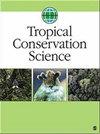Leaf Nutrient Relations of Cycads in a Common Garden
IF 1.6
4区 环境科学与生态学
Q2 BIODIVERSITY CONSERVATION
引用次数: 3
Abstract
Background and Aims Research required to clarify leaf nutrient relations of cycad species has been inadequate. Common garden studies are useful for determining the influence of genetics on leaf traits because of the homogeneous environment among experimental units. To date, there have been no common garden studies which included all ten genera of cycads. The full phylogenetic breadth has, therefore, not been included in this important area of study. Methods We examined macronutrient and micronutrient content of leaves from one representative species from each of the ten cycad genera at Nong Nooch Tropical Botanical Garden in Thailand. Nitrogen content was determined by dry combustion, and the remaining nutrients were quantified by spectrometry. Results The least variable elements were nitrogen and phosphorus, and the most variable elements were boron and sodium. Nutrient content based on leaflet area was more variable than based on leaflet mass, reflecting species differences in specific leaf area. There were no universal macronutrient or micronutrient signals indicating clear phylogenetic distinctions. Implications for Conservation: Active management of threatened cycad taxa requires research to develop the knowledge to enable evidence-based decisions. This common garden study inclusive of all 10 cycad genera creates a foundation to determine leaf nutrient sufficiency ranges to inform management decisions.普通园林中苏铁的叶片营养关系
背景与目的苏铁植物叶片营养关系的研究尚不充分。普通园林研究有助于确定遗传对叶片性状的影响,因为实验单位之间的环境是均匀的。到目前为止,还没有包括苏铁所有十个属的共同园林研究。因此,在这个重要的研究领域中没有包括完整的系统发育广度。方法对泰国Nong Nooch热带植物园10个苏铁属各代表种的叶片进行宏量营养素和微量营养素含量测定。干燃烧法测定氮含量,光谱法测定剩余营养成分。结果变化最小的元素是氮和磷,变化最大的元素是硼和钠。基于小叶面积的养分含量比基于小叶质量的养分含量变化更大,反映了物种比叶面积的差异。没有普遍的宏量营养素或微量营养素信号表明明显的系统发育差异。对保护的启示:主动管理受威胁的苏铁类群需要研究来发展知识,使基于证据的决策。这项包括所有10种苏铁属的普通园林研究为确定叶片营养充足范围提供了基础,从而为管理决策提供信息。
本文章由计算机程序翻译,如有差异,请以英文原文为准。
求助全文
约1分钟内获得全文
求助全文
来源期刊

Tropical Conservation Science
BIODIVERSITY CONSERVATION-
CiteScore
3.60
自引率
5.90%
发文量
16
审稿时长
>12 weeks
期刊介绍:
Tropical Conservation Science is a peer-reviewed, open access journal that publishes original research papers and state-of-the-art reviews of broad interest to the field of conservation of tropical forests and of other tropical ecosystems.
 求助内容:
求助内容: 应助结果提醒方式:
应助结果提醒方式:


